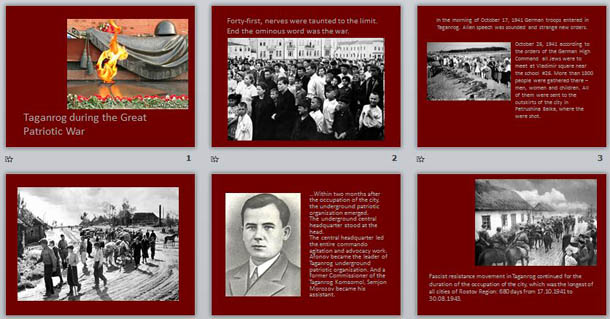
Taganrog during the Great Patriotic War

Forty-first, nerves were taunted to the limit. End the ominous word was the war.

In the morning of October 17, 1941 German troops entered in Taganrog. Alien speech was sounded and strange new orders.
October 26, 1941 according to the orders of the German High Command all Jews were to meet at Vladimir square near the school #26. More than 1800 people were gathered there – men, women and children. All of them were sent to the outskirts of the city in Petrushina Balka, where the were shot.


… Within two months after the occupation of the city, the underground patriotic organization emerged.
The underground central headquarter stood at the head.
The central headquarter led the entire commando agitation and advocacy work.
Afonov became the leader of Taganrog underground patriotic organization. And a former Commissioner of the Taganrog Komsomol, Semjon Morozov became his assistant.

Fascist resistance movement in Taganrog continued for the duration of the occupation of the city, which was the longest of all cities of Rostov Region: 680 days from 17.10.1941 to 30.08.1943.

The entire families – Pertsev, Turubarov, Afonov, Kamenskyh, Zhilenco et al. Were the members of the organization. Most groups were active in the factories “Krasniy Kotelschik”, “Krasniy Hydropress”, Metallurgical plant, on the railroad station.

Before Morozov’s death, meetings were held in the Turubarov’s house (Italianskiy, 107)
On the house where Turubarov’s family lived, has a plaque. Its opening was held on February 25, 1983, to coommemorate the 40 th anniversary of the Taganrog Underground.

Turubarova Raisa Kuzminichna (1926-1943)
She was born in Taganrog. The youngest in the Turubarov’s family. Before the Second World War begins, she studied at school #29. She was a member of the Young Communist League. During the occupation, together with her brother and older sister she took part in the fight against the Nazis. She was arrested in February 1943, was subjected to vile abuse and shot. She was awarded the Order of the Red Star (posthumously).

Turubarova Valentina Kuzminichna (1911-1943)
A native citizen of Taganrog. The sister of Peter Turubarov. She worked as a design technician at the Dimitrov’s plant. During the occupation, she became a member of the group, led by her brother, she carried out all his tasks. She was arrested in February 1943. After the torture and abuse she was shot in the beam. She was awarded with the Order of the Red Star (posthumously).

Taganrog Underground members, despite of their young age, found the strength and courage to fight with the enemy within. Many members of the Underground at that time were 12-17 years old.

July, 12 1943 at dawn, columns sentenced to death patriots walked the streets of the city under the control of a thick chain of armed Gestapo. There were people of different generations that did not inclined their heads under the fascist’s executioners. At that day, the Nazis shot more than 120 heroes of Taganrog Underground.

Through time they talk with us, those who will never return. Our duty is never to forget that terrible war, those who saved their homeland.

In the history of our region there are many moments worthy of attention and respect. One of the most painful memory locations in the southern Russia is the valley of the Mius-river, that in 1941-1942 and 1943 became the area of blooody battles between the Soviet and German armies.

The main line of defense Mius-Front began off the coast of the Azov Sea to the east of Taganrog, then ran along the Mius River, which gave the name to the entire line. Mius-Front for a long time detained the advance of the Red Army in the south, and quite possibly changed the course of events of the war itself.

In general, on the Mius-Front from 1941 to 1943, we have lost more than 800 thousands people, which is approximately 25-30 full-fledged divisions, or 3% of the total losses of the Soviet Army during the war.

Scientists and searchers were raised German tanks from the bottom of the river Mius, on fields of battles conducted excavations. All these, at first glance little, details help us to recover the full picture of those tragic events, which so long withheld, to commemorate the forgotten heroes who sacrificed their lives defending our future.

Memoires of the War…

Memoires of the War…

Memoires of the War…

The Soviet Government highly appreciated the feats of Taganrog patriots during the Great Patriotic War. In 1965-1966 according to the two decrees of the Presidium of the Supreme Soviet of the RSFSR over 100 participants Taganrog underground organization were awarded with orders and medals. The commander of the partisan detachment V.I. Afonov was posthumously awarded with the title Hero of the Soviet Union.
April 6, 1930, approved by the order of Lenin. During the great Patriotic war, the order of Lenin won the battle over 36 thousand people. Was given to persons who already had four orders of the red banner. This award was supposed to be the highest military distinction.

“ The City of Military Glory"
On January 3, 2011 – Dmitry Medvedev signed a decree conferring Taganrog honorary title “The City of the Military Glory”
Today in Russia there 37 cities of the military glory. To of them are Rostov-on-Don and Taganrog, they are located in the Rostov Region.

As pointed out in his speech, Dmitry Anatolyevich Medvedev, “…At the end of the XVII century Taganrog became an outpost of Russia on the coast of the Azov Sea. Fortress city has witnessed a variety of battles. During the Russian-Turkish war and the Crimean War garrison of the Taganrog many times repulsed the enemy attacks”
During the Great Patriotic War Taganrog was under occupation almost 2 years, but difficult conditions did not break the spirit of its inhabitants, who have created an underground organization (one of the largest, by the way, in the south of the country), took part in the operation to liberate their native city. Taganrog was the third after Orel and Belgorod, to celebrate the release of which in our nation’s capital August, 30 1943 took the salute.

Ceremonial presentation of credentials is an important milestone in the history of our city.
The title “The City of Military Glory” has been assigned since 2006. According to the text of the relevant federal law, title is awarded “city in whose territory or in the immediate vicinity of which during the fierce battle defenders of the Fatherland demonstrated the courage, fortitude and heroism.”

The memorial steles will be set in the cities which were awarded the title “The City of the Military Glory” the celebrytory fireworks will be held on the CityDay, 23 rd February and 9 May.
On the occasion of the awarding Taganrog with the title of “The City of the Military Glory”, the Memorial stele will be set.


 Получите свидетельство
Получите свидетельство Вход
Вход





































 Презентация по английскому языку "Таганрог в годы Великой Отечественной войны" (3.43 MB)
Презентация по английскому языку "Таганрог в годы Великой Отечественной войны" (3.43 MB)
 0
0 463
463 58
58 Нравится
0
Нравится
0


